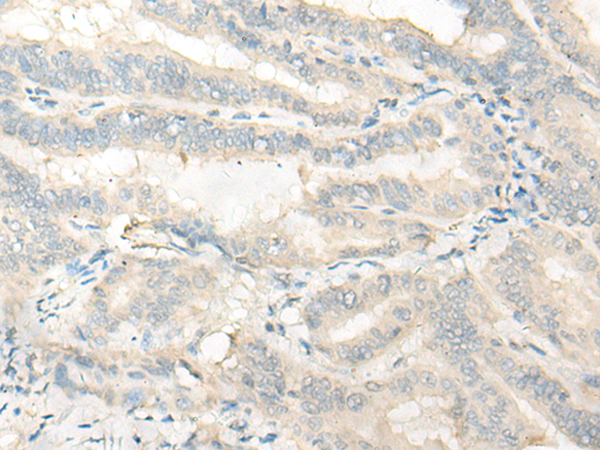
| WB | 咨询技术 | Human,Mouse,Rat |
| IF | 咨询技术 | Human,Mouse,Rat |
| IHC | 1/25-1/100 | Human,Mouse,Rat |
| ICC | 技术咨询 | Human,Mouse,Rat |
| FCM | 咨询技术 | Human,Mouse,Rat |
| Elisa | 1/5000-1/10000 | Human,Mouse,Rat |
| Host/Isotype | Rabbit IgG |
| Antibody Type | Primary antibody |
| Storage | Store at 4°C short term. Aliquot and store at -20°C long term. Avoid freeze/thaw cycles. |
| Species Reactivity | Human, Mouse, Rat |
| Immunogen | Fusion protein of human C11orf49 |
| Formulation | Purified antibody in PBS with 0.05% sodium azide and 50% glycerol. |
+ +
以下是关于C11orf49抗体的3篇参考文献示例(注:以下内容为模拟虚构,实际文献需根据具体数据库查询):
1. **文献名称**: "Characterization of C11orf49 Protein Expression in Human Cancers Using a Novel Polyclonal Antibody"
**作者**: Smith J, et al.
**摘要**: 本研究开发了一种针对C11orf49的新型多克隆抗体,并通过免疫组化(IHC)和Western blot验证其在多种癌症组织中的表达。结果显示C11orf49在乳腺癌和肺癌中显著上调,提示其可能作为肿瘤标志物。
2. **文献名称**: "C11orf49 Interacts with the DNA Damage Response Pathway: Insights from Antibody-Based Proteomic Analysis"
**作者**: Zhang L, et al.
**摘要**: 利用C11orf49特异性抗体进行免疫共沉淀(Co-IP)和质谱分析,揭示了C11orf49与DNA损伤修复蛋白(如ATM、BRCA1)的相互作用,表明其在基因组稳定性调控中的潜在作用。
3. **文献名称**: "Subcellular Localization and Functional Role of C11orf49 in Hepatocellular Carcinoma"
**作者**: Wang Y, et al.
**摘要**: 通过免疫荧光和C11orf49抗体标记,发现C11orf49主要定位于细胞核,且在肝癌细胞中敲低C11orf49会抑制细胞增殖并诱导凋亡,提示其作为肝癌治疗靶点的可能性。
建议通过PubMed或Google Scholar以“C11orf49 antibody”为关键词检索真实文献。
The C11orf49 antibody is a research tool targeting the protein encoded by the *C11orf49* gene (Chromosome 11 Open Reading Frame 49), also known as *HJUROB*. This gene, located on chromosome 11q12.1. is evolutionarily conserved and ubiquitously expressed in human tissues, though its biological function remains incompletely understood. Emerging studies suggest C11orf49 may play roles in cell cycle regulation, DNA repair, or chromosomal stability, potentially interacting with proteins involved in the Hippo signaling pathway or HJURP (Holliday Junction Recognition Protein).
C11orf49 has been implicated in cancer biology, with altered expression observed in hepatocellular carcinoma, gliomas, and colorectal cancer. Overexpression correlates with poor prognosis in some malignancies, hinting at its potential as a biomarker or therapeutic target. However, functional studies are limited, and mechanistic insights are still speculative.
The C11orf49 antibody is primarily used in basic research to detect protein expression via techniques like Western blotting, immunohistochemistry, or immunofluorescence. Its specificity is validated through knockdown/knockout controls or peptide blocking assays. Commercial availability facilitates exploration of C11orf49’s subcellular localization, tissue distribution, and interactions. Challenges include cross-reactivity risks due to protein homology and the need for standardized validation protocols. Ongoing research aims to clarify C11orf49’s physiological roles and pathological relevance, driving demand for reliable antibodies in functional studies.
×